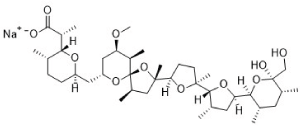Nigericin
-
Cat.code:
tlrl-nig
- Documents
ABOUT
NLRP3 Inflammasome Inducer - Nigericin sodium salt
Nigericin sodium salt is a microbial toxin derived from the gram-positive bacteria Streptomyces hygroscopicus. It triggers the NLRP3 inflammasome-dependent induction of interleukin-1β (IL-1β) and IL-18 [1].
The biological activity of Nigericin has been validated using InvivoGen's THP-1 Null2 cells and HEK-Blue™ IL-1β cells.
Key features
- NLRP3 inflammasome activator
- Potassium ionophore
- Each lot is functionally tested
![]() Read our review on the NLRP3 inflammasome.
Read our review on the NLRP3 inflammasome.
![]() Download our Practical guide on Inflammasomes.
Download our Practical guide on Inflammasomes.
Reference:
1. Mariathasan S. et al., 2006. Cryopyrin activates the inflammasome and ATP. Nature 440;228-32.
All InvivoGen products are for internal research use only, and not for human or veterinary use.
InvivoGen also offers:
SPECIFICATIONS
Specifications
C40H67NaO11
1 - 10 µM
5 mg/ml in ethanol
Cellular assay
Each lot is functionally tested and validated.
CONTENTS
Contents
-
Product:Nigericin
-
Cat code:tlrl-nig
-
Quantity:10 mg
Shipping & Storage
- Shipping method: Room temperature
- -20 °C
- Avoid repeated freeze-thaw cycles
Storage:
Caution:
Details
Nigericin sodium salt acts as a potassium ionophore. It probably activates NLRP3 through the intracellular potassium (K+) efflux across the membrane [1]. Whether the formation of non‑selective pannexin-1 pores also contributes to NLRP3 activation upon Nigericin treatment remains unclear [2].
The NLRP3 inflammasome is an intracellular multi-protein complex that plays a central role in innate immunity. It is activated by a two-step process. A first signal (‘priming’) is provided by pathogen-associated molecular patterns (PAMPs) or cytokines. It allows the transcriptional upregulation of key inflammasome actors and the post-translational modification of NLRP3. The second signal (‘activation’) is provided by a wide array of stimuli including microbial toxins, endogenous molecules, or crystalline substances. The current paradigm is that NLRP3 does not bind directly to these molecules. Rather it senses downstream cytosolic stress signals such as K+ efflux. This triggers inflammasome multimerization and pro-caspase-1 maturation. Proximity-induced autolytic activation of caspase-1 leads to the formation of gasdermin D (GSDMD) pores at the cell surface, allowing IL-1β/IL-18 and alarmin secretion, and ultimately, pyroptosis [3,4].
References:
1. Muñoz-Planillo R. et al., 2013.K+ efflux is the common trigger of NLRP3 inflammasome activation by bacterial toxins and particulate matter. Immunity. 38(6):1142-53..
2. Pelegrin P, & Surprenant A., 2007. Pannexin-1 couples to maitotoxin- and nigericin-induced interleukin-1beta release through a dye uptake-independent pathway. J Biol Chem. 282(4):2386-94.
3. Swanson K.V. et al., 2019. The NLRP3 inflammasome: molecular activation and regulation to therapeutics. Nat. Rev. Immunol. 19:477.
4. Groslambert M. & Py B. 2018. Spotlight on the NLRP3 inflammasome pathway. J. Inflamm. Res. 11:359.
Chemical structure of nigericin:

DOCUMENTS
Documents
Technical Data Sheet
Safety Data Sheet
Validation Data Sheet
Certificate of analysis
Need a CoA ?





